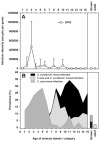Occurrence of Cryptosporidium suis and Cryptosporidium scrofarum on commercial swine farms in the Czech Republic and its associations with age and husbandry practices
- PMID: 23271566
- PMCID: PMC4724874
- DOI: 10.1007/s00436-012-3244-8
Occurrence of Cryptosporidium suis and Cryptosporidium scrofarum on commercial swine farms in the Czech Republic and its associations with age and husbandry practices
Abstract
From 2009 to 2011, the occurrence of Cryptosporidium spp. was investigated on 22 farms in the Czech Republic. A total of 1,620 individual faecal samples of pigs of all age categories (pre-weaned, starters, pre-growers, growers, and sows) were evaluated for presence of Cryptosporidium spp. by standard microscopy and molecular tools. Genotyping was done through PCR amplification and characterization of the SSU rRNA (species-specific protocols) and GP60 loci. Cryptosporidium spp. was found on 16 of 22 farms with a range 0.9-71.4 %. Overall, 194 (12 %) specimens were positive by microscopy and 353 (21.8 %) by PCR. While RFLP and direct sequencing of the PCR-amplified products showed presence of Cryptosporidium suis (142), Cryptosporidium scrofarum (195), Cryptosporidium muris (3) and 13 samples had mixed infections with C. suis and C. scrofarum, species-specific molecular tools identified C. suis (224), C. scrofarum (208), Cryptosporidium parvum subtype IIa A16G1R1b (1), and C. muris (3). In addition, a total of 82 pigs had concurrent infections with C. suis and C. scrofarum. The analysis by age showed that C. suis was primarily detected among pre-weaned, whereas C. scrofarum was mostly detected among starters, especially those weaned at a younger age. Moreover, C. scrofarum never has been detected in animals younger than 6 weeks of age. Also, piglets weaned at 3 weeks of age were twice more likely to be infected with C. scrofarum than piglets weaned at an older age. Pigs raised on straw bedding were more likely to have Cryptosporidium than pigs raised on slats/slurry systems. The infections with different species were not associated with loose faeces or intensity of oocyst shedding, even when comparing different age groups.
Figures


Similar articles
-
Age-related detection and molecular characterization of Cryptosporidium suis and Cryptosporidium scrofarum in pre- and post-weaned piglets and adult pigs in Japan.Parasitol Res. 2014 Jan;113(1):359-65. doi: 10.1007/s00436-013-3662-2. Epub 2013 Nov 5. Parasitol Res. 2014. PMID: 24189974
-
Prevalence and age-related infection of Cryptosporidium suis, C. muris and Cryptosporidium pig genotype II in pigs on a farm complex in the Czech Republic.Vet Parasitol. 2009 Mar 23;160(3-4):319-22. doi: 10.1016/j.vetpar.2008.11.007. Epub 2008 Nov 13. Vet Parasitol. 2009. PMID: 19091471
-
Detection and molecular characterisation of Cryptosporidium spp. in Swedish pigs.Acta Vet Scand. 2020 Jul 29;62(1):40. doi: 10.1186/s13028-020-00537-z. Acta Vet Scand. 2020. PMID: 32727527 Free PMC article.
-
Global prevalence of Cryptosporidium spp. in pigs: a systematic review and meta-analysis.Parasitology. 2023 May;150(6):531-544. doi: 10.1017/S0031182023000276. Epub 2023 Mar 20. Parasitology. 2023. PMID: 37051887 Free PMC article.
-
Rodents as a reservoir of infection caused by multiple zoonotic species/genotypes of C. parvum, C. hominis, C. suis, C. scrofarum, and the first evidence of C. muskrat genotypes I and II of rodents in Europe.Acta Trop. 2017 Aug;172:29-35. doi: 10.1016/j.actatropica.2017.04.013. Epub 2017 Apr 20. Acta Trop. 2017. PMID: 28433573 Review.
Cited by
-
Molecular testing for clinical diagnosis and epidemiological investigations of intestinal parasitic infections.Clin Microbiol Rev. 2014 Apr;27(2):371-418. doi: 10.1128/CMR.00122-13. Clin Microbiol Rev. 2014. PMID: 24696439 Free PMC article. Review.
-
Cryptosporidium suis and Cryptosporidium scrofarum in Eurasian wild boars (Sus scrofa) in Central Europe.Vet Parasitol. 2013 Nov 8;197(3-4):504-8. doi: 10.1016/j.vetpar.2013.07.003. Epub 2013 Jul 12. Vet Parasitol. 2013. PMID: 23916060 Free PMC article.
-
Review of Cryptosporidium and Giardia in the eastern part of Europe, 2016.Euro Surveill. 2018 Jan;23(4):16-00825. doi: 10.2807/1560-7917.ES.2018.23.4.16-00825. Euro Surveill. 2018. PMID: 29382412 Free PMC article. Review.
-
Age-related detection and molecular characterization of Cryptosporidium suis and Cryptosporidium scrofarum in pre- and post-weaned piglets and adult pigs in Japan.Parasitol Res. 2014 Jan;113(1):359-65. doi: 10.1007/s00436-013-3662-2. Epub 2013 Nov 5. Parasitol Res. 2014. PMID: 24189974
-
Molecular identification and epidemiological comparison of Cryptosporidium spp. among different pig breeds in Tibet and Henan, China.BMC Vet Res. 2019 Mar 28;15(1):101. doi: 10.1186/s12917-019-1847-3. BMC Vet Res. 2019. PMID: 30922311 Free PMC article.
References
-
- Argenzio RA, Liacos JA, Levy ML, Meuten DJ, Lecce JG, Powell DW. Villous atrophy, crypt hyperplasia, cellular infiltration, and impaired glucose-Na absorption in enteric cryptosporidiosis of pigs. Gastroenterology. 1990;98:1129–1140. - PubMed
-
- Armson A, Yang R, Thompson J, Johnson J, Reid S, Ryan UM. Giardia genotypes in pigs in Western Australia: prevalence and association with diarrhoea. Exp Parasitol. 2009;121:381–383. - PubMed
-
- Bergeland ME. Necrotic enteritis in nursing piglets. Proc Am Assoc Vet Lab Diagn. 1977;20:151–158.
Publication types
MeSH terms
Grants and funding
LinkOut - more resources
Full Text Sources
Medical
Miscellaneous

